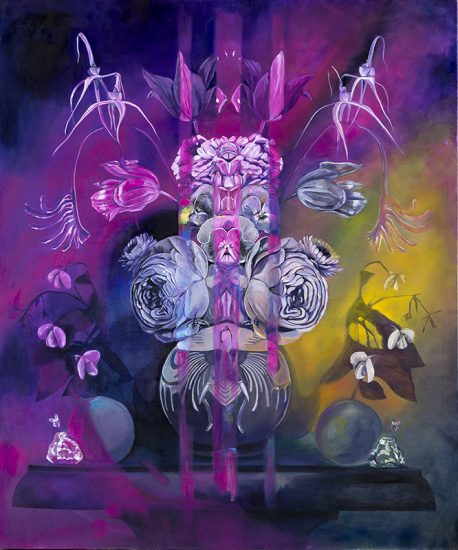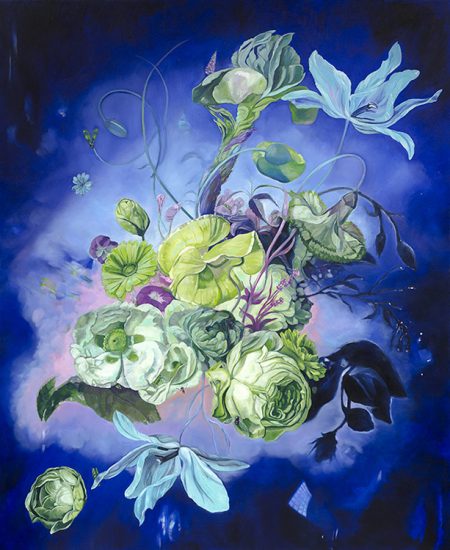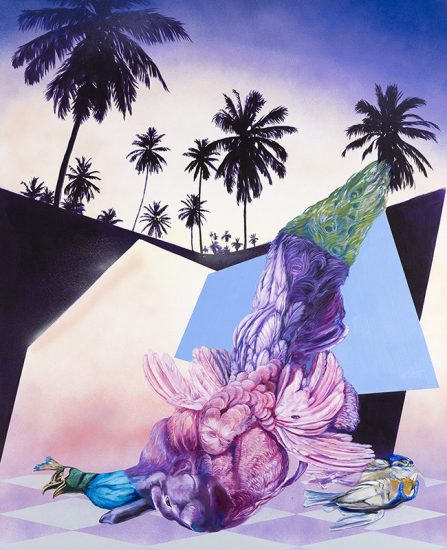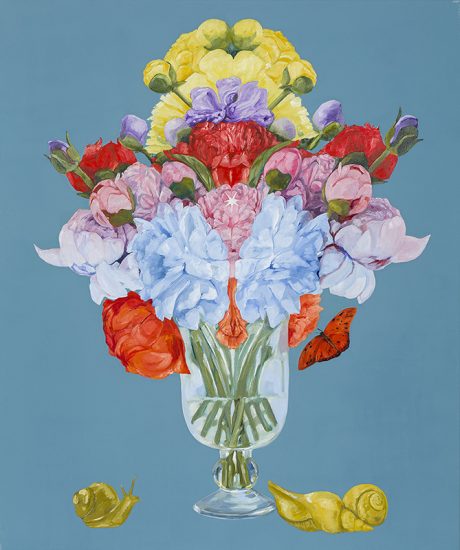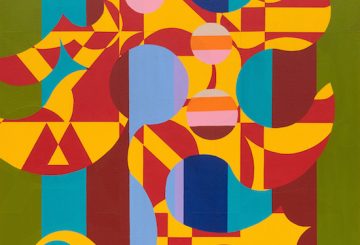Following the opening of her most recent exhibition with Martin Browne Contemporary in Sydney, Art Life editor Andrew Frost spoke with Monika Behrens about the idea behind a ‘thinking image’, their form, colour and a whole lot of other good painting stuff…
Monika Behrens , Echo II, 2016, oil on canvas, 122 x 102 cm
Andrew Frost: The title of your show “The Thinking Image” suggests that the paintings in the show are the result of thinking through a subject on your part, but it could also suggest that the paintings represent a range of ideas about representation in a picture that the viewer needs to ponder. What does the title mean for you?
Monika Behrens: This is a heavy question and sorry about getting into theory stuff straight up, The Thinking Image is aligned with Hanneke Grootenboer’s (Grootenboer 2011) Pensive image. Grootenboer’s concept is derived from Herbert Damisch’s The Origin of Perspective in which he suggests that painting not only displays but also thinks. Grootenboer developed Damisch’s theory, and wrote that “painting is a kind of thinking, and that perspective is a model of thought as much as a system of persuasion.” My title The Thinking Image derives from the idea that painting is a form of thinking, not as a result of a determined analysis but as an interpretation that can be reconstructed in multiple ways through multiple forms.
AF: What do you suppose the relationship of the viewer is to this idea insofar as how someone might respond to the individual painting? Do consider that response in making the work?
MB: I also think that looking at a painting offers a form of thinking to the viewer – more aligned with Grootenboer’s rhetoric than narrative/symbolic analysis. What I mean by this is that compositional and perspective elements in the painting can deliver concepts and questions more slowly and deliberately than a reductive wall text outlining which objects correlate to ideas via symbolism. For example, a viewer can encounter doublings in the painting series That was then this is now and Echo, in which they will be confronted with a mirrored image, and slowly come to realise that there are flowers that are painted in two stages of decay, or there are two shapes that mimic each other or two colours that bounce across the canvas through symmetry.
Monika Behrens, Midnight Sun, 2018, oil on canvas , 168 x 138 cm
AF: The exhibition is made up of three series of paintings, and one extra painting, the ‘heroine picture’ if you like on the MB website… Could you talk about where these series came from in terms of your previous work? What’s the connecting interest here?
MB: In my previous work, I focussed heavily on the symbolism in still life painting, playing objects off other objects and creating something that would question politics. I found that the audience was “reading” the paintings for their message and then dismissing the painting itself. I wanted to bring the focus back to the painting and the composition. So, over the past 4 years, I have been researching Seventeenth Century Dutch still life painting through a PhD at A&D UNSW. I spent a lot of time in the Netherlands looking at different subgenres of the tradition to see what was going on beyond the well-known symbols and icons. I worked closely with Pronk, Hunting Trophies and Floral. In this show, there are two series of works, the Hunting Trophies and Floral. The biggest painting, Midnight Sun is an extension of the floral series and is based on the work by Rachel Rausch that is currently in the Dutch Masters show at the AGNSW. I exploded the composition. The stems of the flowers work as directional lines to continually loop the eye back to the center. This painting is a blending of time – within the one canvas a flower is painted to represent the past, the 17th Century, while being painted in the present.
Monika Behrens, Hunting Trophy I, 2017, acrylic and oil on polycotton, 137 x 112 cm
AF: The recurring subject of the works appears to be the still life, but with a range of settings for a series of floral arrangements, from single colour backgrounds to what appears to be a perspective looking from the bottom of a swimming pool, and impression that’s really reinforced by the addition of palm trees and ferns. But there also seems to be references to vanitas pictures as well. What were you working through with the subject?
MB: Each Dutch still life painting has certain characteristics that place it into a subgenre. Floral still life, is recognisable by highly detailed paintings of abundant and vividly coloured bouquets of flowers, usually in a small pot centred on a ledge with shallow depth in a dark setting. Whereas Traditional Hunting trophies, also known as game pieces, are characterised by arrangements of dead animals – the bounty from a day’s hunt. The animals are displayed on a table or in a rural landscape alongside weapons and other hunting paraphernalia. Through my exploration of the different subgenres, I wanted to portray alternate findings through different compositions (a range of settings). For example, with the Hunting Trophy paintings I found that the animals were all piles on top of each other in a mass, and on initial approach to a painting it is difficult to identify an individual animal. I wanted to exaggerate this and make monsterscapes of combined animal body parts and enhance these surreal beasts by making the perspective slightly off and placing them in contemporary dreamy landscapes with palm trees and ferns in brightly coloured sunsets.
AF: One of the really fascinating aspects of these pictures is how they deal with composition, particularly the use of axial symmetry. What was the effect that you were wanting to achieve with this approach? I find them quite unsettling.
MB: Traditionally Floral still lifes have been analysed through symbols and metaphors of time relating to the fragility of life or the transience of earthly things. With my work, I propose that floral paintings involve the mirroring of time and dimensions beyond their symbols and icons. Through looking at the paintings in the Netherlands and spending time with the physical painting, I have found that traditional floral paintings contain characteristics of doubling, directional lines and shape mimicking. And I explored this in my own work through alternating compositions. The Echo and That was then this is now series use and axial symmetry to exaggerate the doubling effect of the original paintings. Where some of the other floral works contained groups of flowers of the approximate same scale (and colours) were mirrored diagonally.
Monika Behrens, That was then this is now II, 2016, oil on canvas , 92 x 72 cm
AF: And the other aspect of these works is their use of colour – what’s going on??!!
MB: Yes, the colours across the show are pretty wild. The colours in the Echo series were applied to make them distinct from each other. The base image is the same through the series but the colours dramatically vary. These colours are used to transform the image; the bright toxic green pushed forward vividly while the cool blue recedes. These colours are applied through alternative shapes on each canvas, such as the V shape, stripes or circles to further play with the dimensions of the canvas, some flatten and bulge while others lengthen and recede.
AF: How do you suppose this approach to colour sits in the contemporary world, particularly the way colour is rendered online? It suggested to me a connection between the form and colour of your paintings and some of the ideas in post painting practices and post internet art.
MB: Definitely, the colour in these paintings wouldn’t be the same if there wasn’t a strong digital influence. I think there is an unconscious as well as a conscious feeding of digital colour into buttery paint colours. The thought of time has been a reoccurring theme throughout these paintings; there is a present-ness of these Dutch flowers and these paintings speak to that, not that I am painting a flower to remind the viewer of the past but rather keeping the flower forever in the present. I will continue to explore these ideas through toxic vibrancy in future paintings. The next series I intend to research is Breakfast Still Lifes, which are small paintings with a subdued pallet, I am not sure what will happen in the studio yet but I am looking forward to exploring some sort of colour explosion through reflections
Monika Behrens, The Thinking Image Until 4 March at Martin Browne Contemporary
